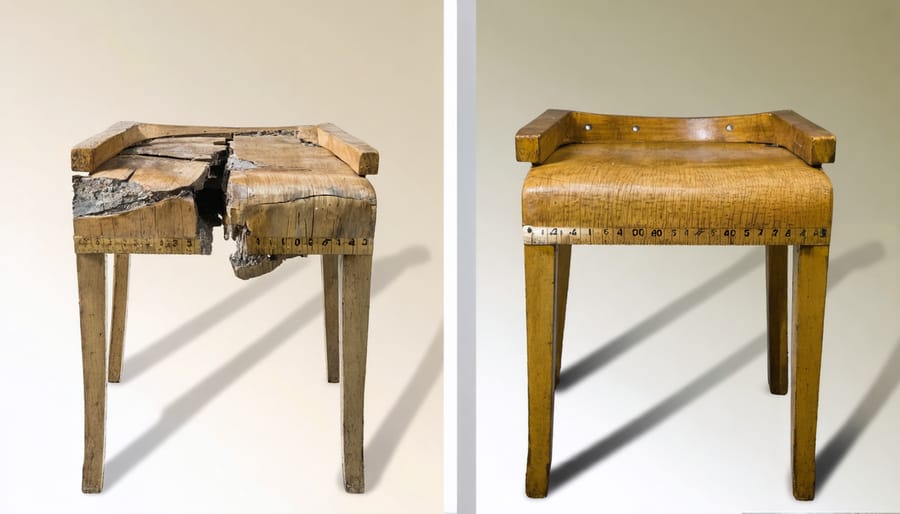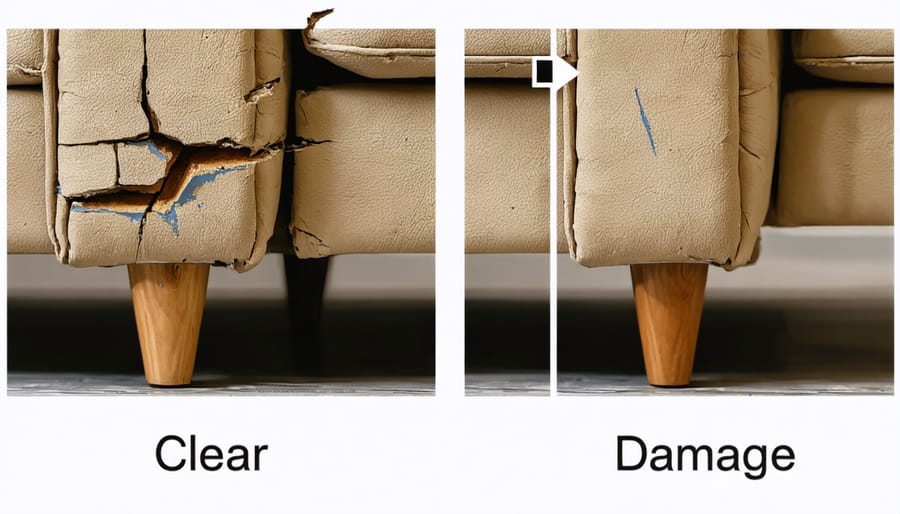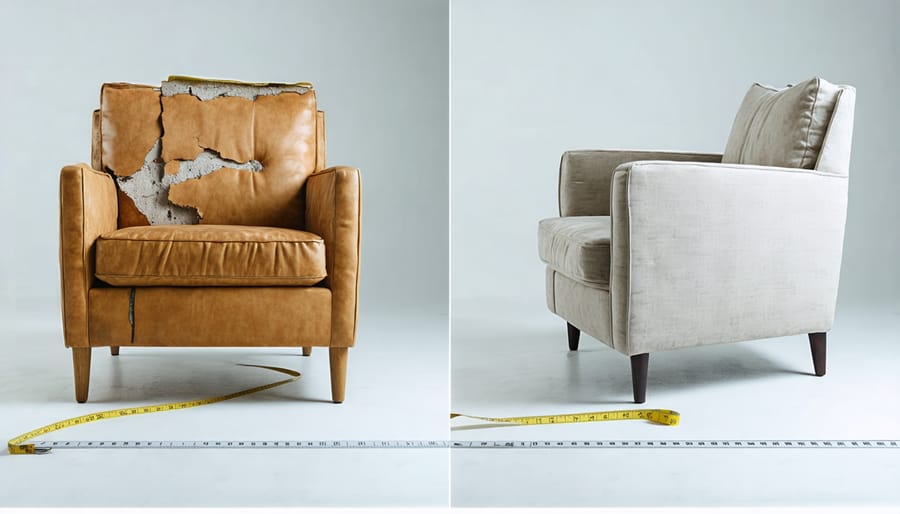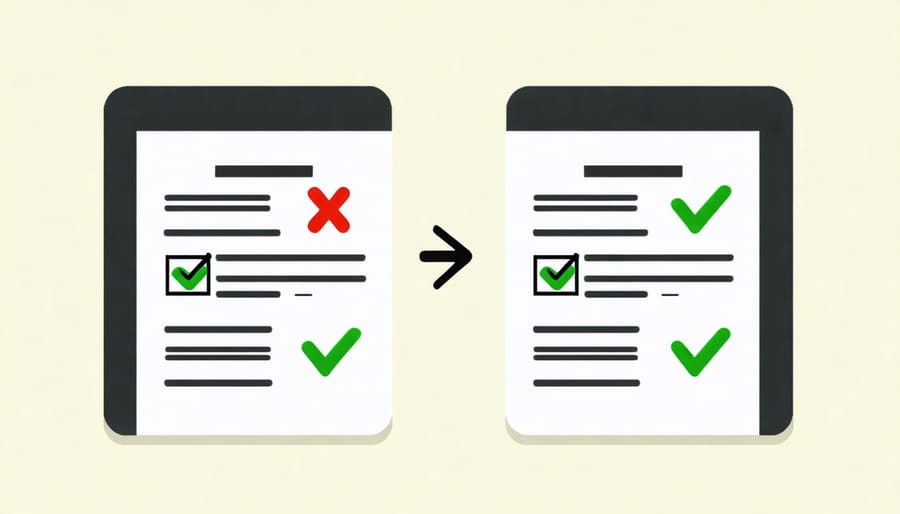
Document structural and cosmetic damage separately when assessing furniture condition – this critical distinction shapes how insurance companies process claims and determine compensation values. Photograph every damaged area from multiple angles under proper lighting, capturing both close-up details and wider contextual shots to document furniture damage like a pro. Measure and record precise dimensions of damaged sections using a ruler or measuring tape, noting specific locations and depths of dents, scratches, or structural failures. Create detailed written descriptions that align with insurance industry terminology, focusing on objective observations rather than subjective assessments – include manufacturer information, original purchase price, and age of the furniture to strengthen your claim’s validity.
Understanding how insurance companies assess damage begins with recognizing the crucial difference between structural and cosmetic damage. Structural damage affects the furniture’s functionality and integrity, such as broken legs, compromised joints, or damaged support mechanisms that make the piece unsafe or unusable. This type of damage typically receives priority in insurance claims because it directly impacts the item’s core purpose.
Cosmetic damage, while visually concerning, primarily affects the furniture’s appearance without compromising its functionality. Examples include surface scratches, minor dents, fabric stains, or slight discoloration. While cosmetic issues may decrease the furniture’s aesthetic value, they often receive different treatment in insurance claims compared to structural problems.
Insurance providers generally prioritize structural damage claims because they relate directly to the furniture’s usability and safety. However, extensive cosmetic damage that significantly reduces the item’s value may also warrant coverage, especially for high-end or antique pieces where appearance is integral to their worth. Understanding this distinction helps property owners prepare more effective insurance claims and make informed decisions about repair options.

Insurance adjusters rely on specific terminology when evaluating furniture damage claims. Understanding and using these key terms correctly can significantly impact your claim’s success. Terms like “structural integrity” refer to a piece’s ability to function safely as intended, while “aesthetic degradation” describes visible damage that affects appearance but not necessarily function.
Watch for phrases such as “operational impairment,” which indicates the furniture no longer works as designed, and “material compromise,” suggesting damage to the core components. Adjusters also note “wear patterns” versus “sudden damage,” distinguishing between normal use and unexpected incidents.
Other crucial terms include “load-bearing capacity” for weight-supporting furniture, “joint stability” for connection points, and “surface deterioration” for finish-related issues. When documenting damage, specifically mention “safety hazards” if the damage creates risks for users, and “restoration potential” to indicate whether repairs are feasible.
Using these industry-standard terms in your documentation demonstrates understanding and professionalism, potentially leading to more favorable claim outcomes.
Proper photo documentation is crucial for accurately capturing furniture damage. Start by ensuring good lighting – natural daylight works best, but if indoors, use bright, even lighting to avoid shadows. Take photos from multiple angles, including wide shots of the entire piece and close-ups of specific damage areas.
When photographing damage, include a ruler or measuring tape in at least one photo to provide scale reference. This helps establish the precise size of scratches, dents, or other imperfections. Ensure your camera lens is clean and focused, as blurry images may not adequately support your documentation.
For comprehensive documentation, capture:
– Full piece from front, back, sides, and top
– Close-ups of each damaged area
– Context shots showing the item’s location
– Serial numbers or manufacturer labels
– Any relevant paperwork or receipts
Avoid common mistakes like using flash (which can create glare), taking photos at odd angles, or having cluttered backgrounds. If possible, use a solid-colored backdrop to highlight the damage clearly.
Time-stamp your photos by enabling your device’s date feature or including a dated newspaper in one shot. Store these images in multiple locations – both digital and physical copies – and organize them systematically with clear file names indicating the piece and damage type.
Remember to document any temporary repairs or changes made to the furniture after the initial damage occurs, as this information may be valuable for insurance claims or professional restoration services.

When documenting functional damage, use clear, descriptive language that focuses on how the damage impacts the item’s intended use. Here’s a template format to follow:
“[Item Name] exhibits [type of damage] on [specific location], preventing normal [function/operation]. The damage measures approximately [dimensions] and affects [specific components].”
Example for a dining chair:
“Dining chair shows structural weakness in the right front leg joint, preventing safe seating. The loose joint creates visible movement of approximately 1 inch when weight is applied, compromising the chair’s stability and making it unsafe for use.”
For drawers or moving parts:
“[Component] fails to [normal function] due to [specific issue]. Normal operation requires [description of extra effort or explains impossibility of use].”
Example for a cabinet:
“Upper cabinet door fails to close completely due to warped hinges. A 3/8-inch gap remains when fully closed, preventing proper storage security and aesthetic appearance.”
For upholstered items:
“[Furniture piece] shows [type of wear/damage] to [specific area], resulting in [functional limitation]. The affected area measures [dimensions] and impacts [specific use case].”
Remember to include specific measurements, avoid subjective language, and focus on how the damage affects the item’s primary function rather than aesthetic concerns alone.

When documenting furniture damage, avoiding certain critical mistakes can make the difference between a successful claim and a frustrating denial. One of the most common errors is insufficient photographic evidence – taking only one or two general photos instead of capturing multiple angles and close-up details of the damage. This oversight often leads to common claim denial reasons that could have been easily prevented.
Another significant mistake is failing to document the damage immediately after discovery. Waiting too long can raise questions about when and how the damage occurred, potentially compromising your claim. Similarly, neglecting to maintain a detailed timeline of events, including when the damage was first noticed and any relevant circumstances, can weaken your case.
Poor description writing is also problematic. Vague statements like “the table is damaged” don’t provide the necessary detail. Instead, be specific: “The dining table has a 6-inch water ring on the top surface and delamination along the eastern edge.”
Many claimants also forget to include important supporting documentation, such as original purchase receipts, maintenance records, or professional assessment reports. These documents help establish the item’s value and condition before the damage occurred.
Lastly, failing to follow proper communication protocols with insurance providers can hurt your claim. Always maintain written records of conversations, including dates, names, and key points discussed. Verbal agreements should be followed up with email confirmations to create a paper trail that supports your claim.
Professional assessment of functional damage by certified experts can significantly strengthen your insurance claim and ensure fair compensation. These specialists bring years of experience and technical knowledge to accurately evaluate the extent of furniture damage, often identifying issues that might not be immediately apparent to untrained eyes.
When you engage a professional assessor, they provide detailed documentation that carries substantial weight with insurance companies. Their reports typically include comprehensive damage analysis, repair cost estimates, and expert opinions on whether restoration is viable or replacement is necessary. This thorough evaluation helps prevent claim disputes and expedites the settlement process.
Insurance adjusters particularly value professional assessments because they follow industry-standard evaluation protocols. These detailed reports often include specialized terminology and specific damage categories that align with insurance policy requirements, making it easier for claims processors to understand and approve your claim.
Moreover, professional assessors can identify secondary damage that might develop over time if left unaddressed. For instance, what appears as minor upholstery damage could indicate underlying structural issues that require immediate attention. Their expertise helps ensure that all potential problems are documented and included in your claim, preventing future complications or denied coverage.
For high-value or antique pieces, professional assessment becomes even more crucial, as these items often require specialized knowledge to accurately determine their pre-damage worth and restoration costs.
Understanding and properly documenting functional damage is crucial for protecting your furniture investments and ensuring successful insurance claims. By following the guidelines outlined in this article, you’ll be better equipped to assess, document, and report damage effectively. Remember to take clear photographs, maintain detailed records, and seek professional evaluation when needed. Don’t hesitate to contact a qualified furniture repair specialist for expert assessment and documentation support. Being proactive in damage documentation not only streamlines the claims process but also helps ensure fair compensation for your damaged furniture. Take action today by creating a documentation system and familiarizing yourself with your insurance policy requirements to protect your valuable furniture assets for years to come.